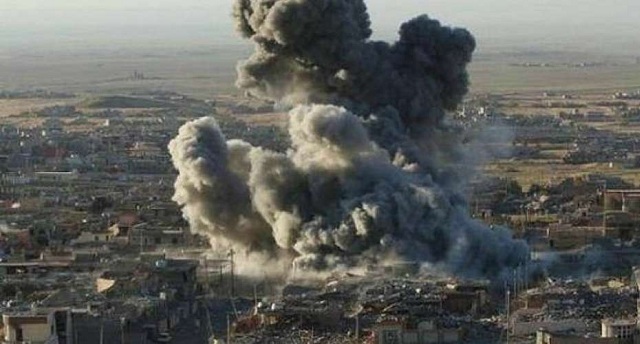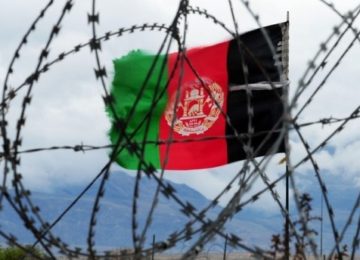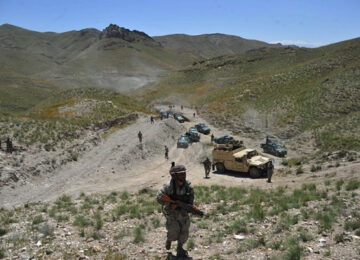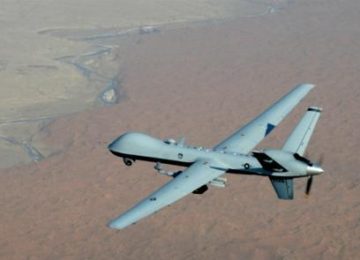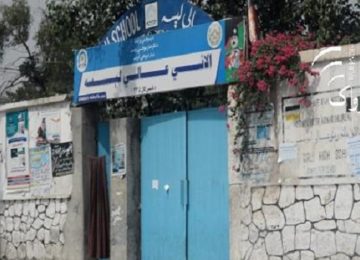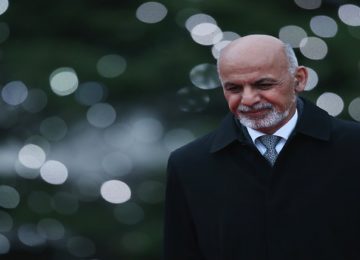UNAMA and Human Rights Watch have each released blistering reports on the killing and wounding of civilians in the Afghan conflict. UNAMA presents the results of its investigation into the Afghan Air Force’s bombing of an open-air graduation ceremony at a madrassa in Dasht-e Archi in Kunduz province in April. It concludes that, even if the air force had a military target, no care was taken to spare the many civilians present, including the dozens of children killed or injured. It is the voices of the civilian victims and survivors of insurgent attacks in urban areas, which are at the heart of the Human Rights Watch publication. Both reports, says AAN’s Kate Clark, make important reading.
In Laghmani village, Dasht-e Archi district of Kunduz province at about 12.30 on 2 April 2018, Afghan Air Force helicopters fired multiple rockets and heavy machine guns during an open-air ‘dastar bandi’ (turban-tying, ie a graduation) ceremony next to a madrassa where hundreds of men and boys had gathered.
The government said the attack had targeted senior Taleban leaders, including members of the Quetta Shura, foreign commanders and members of Taleban ‘special forces’, the Red Unit, whom it said had gathered to plan a military campaign to attack Kunduz city. It had had the area under surveillance, it said, for a week.
UNAMA said it could not verify the civilian status of each person killed or injured, but found that the crowd gathered for the ceremony “was primarily civilian.” Among them was a large number of children, “many under the age of ten.” UNAMA notes that people had come to attend a ceremony that was “religious in nature” and which had been “widely advertised.” The attack was launched when lunch was about to be served. The crowd, it said, “included members of the community, including children,” who had come to observe the ceremony or eat the meal.
UNAMA’s methodology requires three independent sources to confirm civilian status. It said it had verified 107 civilian casualties (36 killed and 71 injured). They included 81 children (30 killed and 51 injured). The civilian status of a further 15 casualties (2 killed and 13 injured, including six children) was partially verified, ie by two independent sources. (In total, it received more than 200 allegations of civilian casualties.) UNAMA acknowledges that the figures presented in its report may “not be exhaustive” be because of “these stringent verification standards and the challenges of obtaining information.”
UNAMA said it is not in a position to judge whether Taleban were present or not (some locals reported to it that there had been unarmed Taleban in the crowd and a number of armed Taleban taking care of security). However, it said that even if the government had a legitimate military target, “[t]he high numbers of child casualties resulting from this attack, which took place in a civilian area during a religious ceremony, combined with the use of imprecise weapons in this context, raise questions as to the respect by the government of the rules of precaution and proportionality.” It was “reasonably foreseeable” UNAMA said, that “an attack against this area, using imprecise weapons, during a religious ceremony would have caused a large number of civilian casualties, with lethal indiscriminate effects.”
Reading UNAMA’s account, it is hard to see how, at the very least, the Afghan Air Force pilots could have failed to see the many children present, sitting separately at the rear of the ceremony. It seems they must have seen them, but gone ahead with the attack anyway. Indeed, according to the victims and witnesses interviewed by UNAMA, the helicopters struck the children first.
Local residents told UNAMA they believed the government authorities “viewed civilian populations in areas under Taliban control, such as Dasht-e-Archi, with suspicion. They expressed concern that this may be resulting in their differential treatment.”
Despite UNAMA’s use of careful, sober language, the gravity of what it is saying is clear. The Afghan Air Force did not protect, or even mitigate the harm it did to civilians. It failed to discriminate between civilians and combatants. Finally, the suspicion from the population is that the government considers anyone who lives in a Taleban-controlled area as an enemy. UNAMA reminds the government that civilians remain civilians wherever they live and must be spared.
Human Rights Watch report ‘“No Safe Place”: Insurgent Attacks on Civilians in Afghanistan.’
Human Rights Watch’s report on the experiences of civilians killed and wounded by Taleban and the Islamic State in Khorasan Province (ISKP) is excoriating. Here, it is the stories of survivors and relatives of victims told in their own words that are so compelling. HRW has heard from people in Kabul, Jalalabad and Herat who were “walking down the street, working in a shop, preparing food at home, or worshipping in a mosque” when they experienced “sudden and terrifying violence.” They were victims of attacks which intentionally targeted civilians – in mosques, schools and hospitals – or failed to discriminate between civilians and combatants or to mitigate the harm done while attacking a military target, causing disproportionate harm.
Civilian casualties often end up as statistics: the numbers are important, but so are the individuals. To take just one example from the many victims featured in HRW’s report, M Ahmadi, a property dealer, was in his shop on 24 July 2017 when the Taleban carried out a suicide bombing against a staff shuttle bus from the Ministry of Mines. The Taleban claimed they had hit an NDS bus. Even if that had been true, the attack in a busy area of Kabul was bound to kill and injure civilians like M Ahmadi. 38 civilians were killed in the attack and he was among the dozens injured.
I was in my shop…. I heard a very loud sound and I did not know what happened…. I was not hearing well, and somebody pushed me and said, “Get out!” The staff shuttle bus for the Ministry of Mines that had been bombed had crashed into my shop. I walked out with bare feet and the broken glass cut into my feet. My shop was on fire. There were fires on both sides of the street.
Out on the street a car stopped in front of him and the driver told him to get in: He took me to Mawla Hospital and he called my family to let them know. Then my sons brought me to Emergency Hospital. I do not remember how long I was there. My head, my belly, and my arm were injured—there are still shell fragments in my arm…. During the night I scream in my sleep. The doctors told me I need to see a psychiatrist. But I cannot because of the money.
My family asks me not to go to work, but what can I do? This shop is mine, and I had to borrow a lot of money to repair it. I am the only breadwinner in the family. Due to our financial problems, my children can’t go to school now. Why doesn’t the government give some money to help the injured people in this area? Aren’t we from this land, from this country?
M Ahmadi’s account is typical in many ways, describing how the consequences of an attack are not just immediate and physical, but also psychological, financial and long-lasting, with the devastation rippling through many lives. Some of the victims telling their stories have been left with permanent disabilities or are the orphans or widows of those killed.
Human Rights Watch says that, although no statistics are available, its research suggests “a large proportion of those killed and injured have been the very poor.” That poor people may be more at risk from attacks could be anticipated. The very rich use armoured cars and live behind concrete walls. Even the somewhat well off may be able to afford the choice of not working in or near places of high risk, although they may still be caught up in attacks as passers-by. Who, but the poorest with no economic alternative would spend large amounts of their working days near a high-risk location like the old Ministry of Interior? It was attacked by the Taleban with an ambulance rigged with explosives on 27 January 2017. More than 100 people were killed and 200 injured, including, said HRW, street children, peddlers and kiosk vendors. HRW makes the point that such victims and their families are also the least able to cope with the severe financial hardship of losing a breadwinner, or permanent disability or of losing what little in the way of the tools of their trade they might have had.
The government has a laudable policy of providing assistance to victims of the conflict regardless of who the perpetrator was. The sums are small, but many victims told HRW help had not been forthcoming. Others described the process for obtaining the assistance as “prohibitively onerous, or was tainted by corruption, with some receiving assistance and others not.” There is rarely the necessary assistance for complex medical needs and scarcely any provision for psycho-social support.Nongovernmental services, HRW said, were overwhelmed. “Whatever animosity they felt toward those who had carried out the attack,” HRW said, victims also described “feeling abandoned by the government and the international community.” Every person interviewed for the report, it said, described “living with fear that other loved ones would die or be injured in the next catastrophic attack.”
Conclusion
In 2017, one third of the civilians killed and injured by insurgents were victims of suicide attacks. Such attacks in urban areas, which inevitably or intentionally cause mass civilian casualties, have been have part of the Taleban’s ‘portfolio of operations’ since the mid-2000s. Last year saw a dramatic increase in the number and magnitude of such attacks, as ISKP has increasingly and intentionally targeted civilian city dwellers, particularly Shia Muslims.
This trend has come “in tandem,” HRW said, with “increased military operations by Afghan National Security Forces (ANSF) and United States forces in provinces where the Taliban have made significant territorial gains.” That increase has included air attacks – the subject of Human Rights Watch’s next report. While still only causing six per cent of overall civilian casualties, the total number of civilians killed and injured in air strikes is rising, with 2017 the worst year since UNAMA systematically started compiling statistics in 2009. (1)
In October 2017, we wrote that every single previous Afghan government or armed group with access to airpower since 1978 had deliberately targeted civilians. What makes the Dasht-e Archi bombing so disturbing is the possibility that the current Afghan Air Force may have crossed that line. When and if any Afghan party to the conflict ceases to see all Afghan civilians as ‘their people’, whether that is city-dwellers for the Taleban or those living in rural Taleban-controlled areas for government forces, the door is opened to indiscriminate violence.
(1) Conclusions on the impact of air strikes are complex. The increased United States and Afghan government air cover may be one reason why civilians casualties from insurgent ground offensives fell last year, pushing an overall slight fall in numbers: the risk of air strikes made it riskier for the Taleban to gather in large numbers to launch offensives. (For numbers, see UNAMA’s 2017 Protection of Civilians report, with AAN analysis here.
Increased air operations also resulted in a record number of civilians killed and injured in air strikes in 2017. However, the increase in sorties flown and weapons dropped in 2017 was far higher than the increase in civilian casualties, indicating that the quality of safeguards was not falling. As UNAMA put it, “the reduced harm ratio suggests improvements in targeting and civilian protection procedures.” Even so, it also said:
…as civilian casualties from aerial operations reached record high levels in 2017, UNAMA once again recommends that both the Afghan Air Force and international military forces review targeting criteria and pre-engagement precautionary measures, including considering the high likelihood of civilian presence in populated areas and starting from a position of considering all persons to be civilians unless determined otherwise.
By Special Arrangement with AAN. Original link.
Disclaimer: Views expressed on this blog are not necessarily endorsed or supported by the Center for Research and Security Studies, Islamabad.



